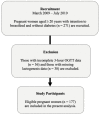Associations of Metabolic and Obstetric Risk Parameters with Timing of Lactogenesis II
- PMID: 35215526
- PMCID: PMC8879345
- DOI: 10.3390/nu14040876
Associations of Metabolic and Obstetric Risk Parameters with Timing of Lactogenesis II
Abstract
Lactogenesis II is the onset of copious milk production following parturition. Delayed onset of lactogenesis II (DLII) often contributes to poorer lactation performance, which may adversely affect maternal and child health. The present study aims to identify the metabolic and obstetric risk factors for DLII in a secondary analysis of a prospective cohort study following pregnant women through postpartum. We defined the onset of lactogenesis II as delayed if it occurred ≥72 h postpartum. Multiple logistic regression analyses were conducted to evaluate the associations of metabolic and obstetric variables with DLII. Median onset of lactogenesis II was 72.4 h (IQR 60.4-91.6) postpartum, and 55.4% (98 of 177) of women experienced DLII. Time to first breast contact ≥ 2 h postpartum compared to ≤1 h postpartum was associated with DLII (OR 2.71 95% CI 1.12-6.53) with adjustment for age, race, pregravid BMI, primiparity, and mode of delivery, while metabolic variables were not significantly associated with DLII. In this comprehensive examination of potential metabolic and obstetric parameters, earlier timing of putting the infant to the breast remained significantly associated with earlier onset of milk coming in after consideration of the other potential risk factors. Obstetrical practices, including putting the baby to the breast later, may have an important impact on the timing of lactation, and interventions are needed to address this concern.
Keywords: DLII; breastfeeding; delayed onset of lactogenesis II; human milk; infant; lactation; metabolic; mother; obstetric; pregnancy.
Conflict of interest statement
The authors declare no conflict of interest.
Figures
Similar articles
-
Delayed onset lactogenesis II predicts the cessation of any or exclusive breastfeeding.J Pediatr. 2012 Oct;161(4):608-14. doi: 10.1016/j.jpeds.2012.03.035. Epub 2012 May 9. J Pediatr. 2012. PMID: 22575242 Free PMC article.
-
Prepregnant overweight and obesity diminish the prolactin response to suckling in the first week postpartum.Pediatrics. 2004 May;113(5):e465-71. doi: 10.1542/peds.113.5.e465. Pediatrics. 2004. PMID: 15121990
-
Risk Factors for Delayed Onset of Lactogenesis II Among Primiparous Mothers from a Brazilian Baby-Friendly Hospital.J Hum Lact. 2020 Feb;36(1):146-156. doi: 10.1177/0890334419835174. Epub 2019 Mar 22. J Hum Lact. 2020. PMID: 30901295
-
Prevalence and risk factors of delayed onset lactogenesis II in China: a systematic review and meta-analysis.J Matern Fetal Neonatal Med. 2023 Dec;36(1):2214833. doi: 10.1080/14767058.2023.2214833. J Matern Fetal Neonatal Med. 2023. PMID: 37258287
-
Does Circadian Disruption Play a Role in the Metabolic-Hormonal Link to Delayed Lactogenesis II?Front Nutr. 2015 Feb 23;2:4. doi: 10.3389/fnut.2015.00004. eCollection 2015. Front Nutr. 2015. PMID: 25988133 Free PMC article. Review.
Cited by
-
Determinants of delayed onset of lactogenesis II among women who delivered via Cesarean section at a tertiary hospital in China: a prospective cohort study.Int Breastfeed J. 2022 Nov 30;17(1):81. doi: 10.1186/s13006-022-00523-3. Int Breastfeed J. 2022. PMID: 36451171 Free PMC article.
-
Multisensory stimulation and its effect on breast milk volume production in mothers of premature infants.Front Pediatr. 2024 Mar 14;12:1331310. doi: 10.3389/fped.2024.1331310. eCollection 2024. Front Pediatr. 2024. PMID: 38550631 Free PMC article.
-
Factors Influencing Delayed Onset of Lactogenesis: A Scoping Review.Int J Gen Med. 2024 May 21;17:2311-2326. doi: 10.2147/IJGM.S452108. eCollection 2024. Int J Gen Med. 2024. PMID: 38799202 Free PMC article.
-
Effect of individualized nutrition interventions on clinical outcomes of pregnant women with gestational diabetes mellitus.World J Diabetes. 2023 Oct 15;14(10):1524-1531. doi: 10.4239/wjd.v14.i10.1524. World J Diabetes. 2023. PMID: 37970125 Free PMC article.
-
Decision-making process of breastfeeding behavior in mothers with gestational diabetes mellitus based on health belief model.BMC Pregnancy Childbirth. 2023 Apr 12;23(1):242. doi: 10.1186/s12884-023-05527-3. BMC Pregnancy Childbirth. 2023. PMID: 37046224 Free PMC article.
References
-
- World Health Organization (WHO) Infant and Young Child Feeding 2021. [(accessed on 20 December 2021)]. Available online: https://www.who.int/news-room/fact-sheets/detail/infant-and-young-child-....
-
- American Academy of Pediatrics (AAP) AAP Recommendations on Breastfeeding 2021. [(accessed on 20 December 2021)]. Available online: https://publications.aap.org/redbook/book/347/chapter-abstract/5749497/A....
-
- Ley S.H., O’Connor D.L., Retnakaran R., Hamilton J.K., Sermer M., Zinman B., Hanley A.J. Impact of maternal metabolic abnormalities in pregnancy on human milk and subsequent infant metabolic development: Methodology and design. BMC Public Health. 2010;10:590. doi: 10.1186/1471-2458-10-590. - DOI - PMC - PubMed
-
- Panuganti P.L., Bazzano L.A., Ley S.H. Human Milk: Sampling and Measurement of Energy-Yielding Nutrients and Other Macromolecules. Academic Press; Cambridge, MA USA: 2021. Hormones in Human Milk: A Summary of the Quantity, Determinants, and Health Outcomes of Milk Hormones; pp. 235–274.
MeSH terms
Grants and funding
LinkOut - more resources
Full Text Sources
Medical


